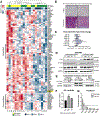Neoadjuvant Chemotherapy Induces Genomic and Transcriptomic Changes in Ovarian Cancer
- PMID: 34737212
- PMCID: PMC8936832
- DOI: 10.1158/0008-5472.CAN-21-1467
Neoadjuvant Chemotherapy Induces Genomic and Transcriptomic Changes in Ovarian Cancer
Abstract
The growing use of neoadjuvant chemotherapy to treat advanced stage high-grade serous ovarian cancer (HGSOC) creates an opportunity to better understand chemotherapy-induced mutational and gene expression changes. Here we performed a cohort study including 34 patients with advanced stage IIIC or IV HGSOC to assess changes in the tumor genome and transcriptome in women receiving neoadjuvant chemotherapy. RNA sequencing and panel DNA sequencing of 596 cancer-related genes was performed on paired formalin-fixed paraffin-embedded specimens collected before and after chemotherapy, and differentially expressed genes (DEG) and copy-number variations (CNV) in pre- and post-chemotherapy samples were identified. Following tissue and sequencing quality control, the final patient cohort consisted of 32 paired DNA and 20 paired RNA samples. Genomic analysis of paired samples did not reveal any recurrent chemotherapy-induced mutations. Gene expression analyses found that most DEGs were upregulated by chemotherapy, primarily in the chemotherapy-resistant specimens. AP-1 transcription factor family genes (FOS, FOSB, FRA-1) were particularly upregulated in chemotherapy-resistant samples. CNV analysis identified recurrent 11q23.1 amplification, which encompasses SIK2. In vitro, combined treatment with AP-1 or SIK2 inhibitors with carboplatin or paclitaxel demonstrated synergistic effects. These data suggest that AP-1 activity and SIK2 copy-number amplification are induced by chemotherapy and may represent mechanisms by which chemotherapy resistance evolves in HGSOC. AP-1 and SIK2 are druggable targets with available small molecule inhibitors and represent potential targets to circumvent chemotherapy resistance. SIGNIFICANCE: Genomic and transcriptomic analyses identify increased AP-1 activity and SIK2 copy-number amplifications in resistant ovarian cancer following neoadjuvant chemotherapy, uncovering synergistic effects of AP-1 and SIK2 inhibitors with chemotherapy.
©2021 American Association for Cancer Research.
Conflict of interest statement
Figures




References
-
- Vergote I, Coens C, Nankivell M, Kristensen GB, Parmar MKB, Ehlen T, et al. Neoadjuvant chemotherapy versus debulking surgery in advanced tubo-ovarian cancers: pooled analysis of individual patient data from the EORTC 55971 and CHORUS trials. Lancet Oncol 2018;19:1680–7 - PubMed
Publication types
MeSH terms
Grants and funding
LinkOut - more resources
Full Text Sources
Medical
Miscellaneous

